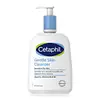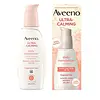Cetaphil Gentle Skin Cleanser Versus Aveeno Ultra-Calming Fragrance-Free Daily Facial Moisturizer With SPF 30
What's inside
What's inside
 Key Ingredients
Key Ingredients

 Benefits
Benefits

 Concerns
Concerns

 Ingredients Side-by-side
Ingredients Side-by-side

Titanium Dioxide 4.3%
Cosmetic ColorantZinc Oxide 3%
Cosmetic ColorantWater
Skin ConditioningC12-15 Alkyl Benzoate
AntimicrobialCyclopentasiloxane
EmollientGlycerin
HumectantStyrene/Acrylates Copolymer
Isopropyl Myristate
EmollientCetyl Dimethicone
EmollientOctyldodecyl Neopentanoate
EmollientGlyceryl Behenate
EmollientPEG-100 Stearate
Glyceryl Stearate
EmollientBenzyl Alcohol
PerfumingAluminum Stearate
Cosmetic ColorantArachidyl Alcohol
EmollientEthylhexylglycerin
Skin ConditioningPolyhydroxystearic Acid
EmulsifyingCaprylyl Glycol
EmollientBehenyl Alcohol
EmollientAlumina
AbrasiveHydroxyethyl Acrylate/Sodium Acryloyldimethyl Taurate Copolymer
Emulsion StabilisingXanthan Gum
EmulsifyingCitric Acid
BufferingMethyldihydrojasmonate
MaskingSqualane
EmollientArachidyl Glucoside
EmulsifyingDimethicone
EmollientChlorphenesin
AntimicrobialTriethoxycaprylylsilane
Dipropylene Glycol Dibenzoate
EmollientChrysanthemum Parthenium Flower/Leaf/Stem Juice
AntioxidantPPG-15 Stearyl Ether Benzoate
EmollientAcrylates/Dimethicone Copolymer
Skin ConditioningSodium Citrate
BufferingPolysorbate 60
EmulsifyingAlpha-Isomethyl Ionone
PerfumingMethyl Ionones
MaskingCeramide NP
Skin ConditioningAvena Sativa Kernel Extract
AbrasiveTitanium Dioxide 4.3%, Zinc Oxide 3%, Water, C12-15 Alkyl Benzoate, Cyclopentasiloxane, Glycerin, Styrene/Acrylates Copolymer, Isopropyl Myristate, Cetyl Dimethicone, Octyldodecyl Neopentanoate, Glyceryl Behenate, PEG-100 Stearate, Glyceryl Stearate, Benzyl Alcohol, Aluminum Stearate, Arachidyl Alcohol, Ethylhexylglycerin, Polyhydroxystearic Acid, Caprylyl Glycol, Behenyl Alcohol, Alumina, Hydroxyethyl Acrylate/Sodium Acryloyldimethyl Taurate Copolymer, Xanthan Gum, Citric Acid, Methyldihydrojasmonate, Squalane, Arachidyl Glucoside, Dimethicone, Chlorphenesin, Triethoxycaprylylsilane, Dipropylene Glycol Dibenzoate, Chrysanthemum Parthenium Flower/Leaf/Stem Juice, PPG-15 Stearyl Ether Benzoate, Acrylates/Dimethicone Copolymer, Sodium Citrate, Polysorbate 60, Alpha-Isomethyl Ionone, Methyl Ionones, Ceramide NP, Avena Sativa Kernel Extract
 Reviews
Reviews

Ingredients Explained
These ingredients are found in both products.
Ingredients higher up in an ingredient list are typically present in a larger amount.
Citric Acid is an alpha hydroxy acid (AHA) naturally found in citrus fruits like oranges, lemons, and limes.
Like other AHAs, citric acid can exfoliate skin by breaking down the bonds that hold dead skin cells together. This helps reveal smoother and brighter skin underneath.
However, this exfoliating effect only happens at high concentrations (20%) which can be hard to find in cosmetic products.
Due to this, citric acid is usually included in small amounts as a pH adjuster. This helps keep products slightly more acidic and compatible with skin's natural pH.
In skincare formulas, citric acid can:
While it can provide some skin benefits, research shows lactic acid and glycolic acid are generally more effective and less irritating exfoliants.
Most citric acid used in skincare today is made by fermenting sugars (usually from molasses). This synthetic version is identical to the natural citrus form but easier to stabilize and use in formulations.
Read more about some other popular AHA's here:
Learn more about Citric AcidGlycerin is already naturally found in your skin. It helps moisturize and protect your skin.
A study from 2016 found glycerin to be more effective as a humectant than AHAs and hyaluronic acid.
As a humectant, it helps the skin stay hydrated by pulling moisture to your skin. The low molecular weight of glycerin allows it to pull moisture into the deeper layers of your skin.
Hydrated skin improves your skin barrier; Your skin barrier helps protect against irritants and bacteria.
Glycerin has also been found to have antimicrobial and antiviral properties. Due to these properties, glycerin is often used in wound and burn treatments.
In cosmetics, glycerin is usually derived from plants such as soybean or palm. However, it can also be sourced from animals, such as tallow or animal fat.
This ingredient is organic, colorless, odorless, and non-toxic.
Glycerin is the name for this ingredient in American English. British English uses Glycerol/Glycerine.
Learn more about GlycerinWater. It's the most common cosmetic ingredient of all. You'll usually see it at the top of ingredient lists, meaning that it makes up the largest part of the product.
So why is it so popular? Water most often acts as a solvent - this means that it helps dissolve other ingredients into the formulation.
You'll also recognize water as that liquid we all need to stay alive. If you see this, drink a glass of water. Stay hydrated!
Learn more about WaterXanthan gum is used as a stabilizer and thickener within cosmetic products. It helps give products a sticky, thick feeling - preventing them from being too runny.
On the technical side of things, xanthan gum is a polysaccharide - a combination consisting of multiple sugar molecules bonded together.
Xanthan gum is a pretty common and great ingredient. It is a natural, non-toxic, non-irritating ingredient that is also commonly used in food products.
Learn more about Xanthan Gum